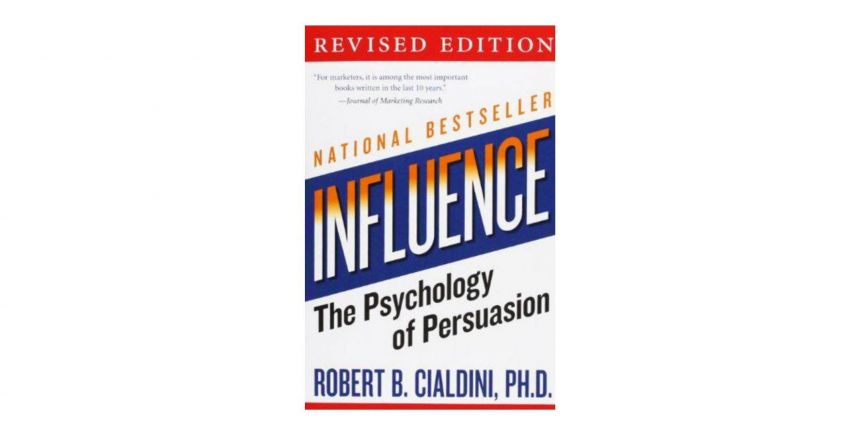Influence: The Psychology of Persuasion by Robert B. Cialdini
A well-written book focusing on the many methods that can be used to influence people. The author of this book is Robert Cialdini, a well-known psychologist who has written books on various subjects. The author’s main focus is on teaching you how to use various types of tools to influence people and, in turn, have them change their behaviors to your benefit.
There are many things that the author will point out to help you better understand what he is talking about. He also teaches you about how your mindset affects your actions. This is important to remember because people fail to realize that they have a choice when it comes to what their actions will be. It may seem that there is only one option, and that is to comply with whatever the person or group wants them to do. However, as a person or group becomes more powerful, it becomes increasingly difficult to get away with what they want, and this is where the power of being able to make a decision comes in. The author’s research and study of many studies on the human mind have helped him develop some great theories that you will definitely take advantage of.
As I mentioned in my review of the book, this book was very well written. The author’s research is impeccable, and how he gives you the techniques and strategies that you can use to influence others is outstanding. I highly recommend that you read this book and hopefully use some of the techniques outlined in it to improve your own personal life and business practices.
Summary
Influence: The Psychology of Persuasion by Robert B Cialdini. Cialdini has identified 7 key influencers of persuasion (based on 35 years of evidence-based research): Weapons of influence (aka the reason why), Reciprocation, Commitment & Consistency, Social Proof, Liking, Authority, and Scarcity.
Important Aspects of Influence & Persuasion
Reason Why – Attaching a reason to some petition raises the success rate: “I have 5 pages, may I use the Xerox machine before you since I am in a hurry” had a success rate of 94% vs. 60% success rate when no reason was granted.
Showing prospective clients the costly thing first, then working at price contributes to a rise in the amount spent (since the upcoming products appear more economical compared ).
1. Reciprocation
Social obligations – People inherently dislike being indebted to somebody, so much so that often a little gift or favor will cause a bigger reciprocal reaction.
Reject & Retreat – This technique is made by initially requiring a high cost (or a massive rep), then waiting for it to be reversed, to stick to up this demand using a smaller one (which you wanted all along).
Quotation from a kid:’If you would like a kitty, first request a pony’ (Ed).
2. Commitment and Consistency
We are inclined to stay consistent with our responsibilities once we’ve created them (consistency is an attractive attribute ). Studies reveal that if individuals are asked if they’d vote, it contributed to a heightened likelihood of following-through to vote. That is the reason it’s encouraged to compose and verbally state our objectives, as we afterward endure the difficulties and have a much greater prospect of sticking to them.
Living up to our identity – “We are what we repeatedly do”- Aristotle.
Therefore, we’ll behave in ways that are consistent with our individuality, values, and beliefs.
3. Social Proof
People’s actions affect other individuals. Consequently, for unknown occasions or scenarios, we look to other people about the right etiquette.
4. Liking
Generally, we would rather say yes to this petition of those we enjoy over those we do not. Many important attributes determine our perspective of individuals:
- Attractiveness
- Similarity
- Compliments
- touch co-operation
- Conditioning
- Institution
Moreover, studies reveal we automatically attribute traits likeability, kindness, wisdom, and honesty to attractive men and women.
Endless chain – When a salesman tactic mentions that they were recommended, stating”your friend recommended that for you,” it raises the chance they’ll make a buy. Turning away from the salesman is tough since it is like rejecting one’s buddy.
5. Authority
The higher the perceived power of an individual, the more likely men and women are to honor them.
We frequently perceive and interact with individuals with authority otherwise. The more energy an individual has been deemed to possess, the more generous individuals are when estimating their elevation, and also the more attentive we are with our discussions.
6. Scarcity
We’re more motivated to behave if we believe we will eliminate something than when we want to acquire something. ‘Save 50 per month on…’ wouldn’t be as successful as ‘You’re losing #50 per month on…’. To be a rare product can be more desirable than those that are publicly offered.

Brief Quotes from Influence: The Psychology of Persuasion
“A well-known principle of human behavior says that when we ask someone to do us a favor we will be more successful if we provide a reason. People simply like to have reasons for what they do.” ― Robert B. Cialdini, Influence
“Embarrassment is a villain to be crushed.” ― Robert B. Cialdini, Influence
“Where all think alike, no one thinks very much. —WALTER LIPPMANN” ― Robert B. Cialdini, Influence
“Often we don’t realize that our attitude toward something has been influenced by the number of times we have been exposed to it in the past.” ― Robert B. Cialdini, Influence
“There is a natural human tendency to dislike a person who brings us unpleasant information, even when that person did not cause the bad news. The simple association with it is enough to stimulate our dislike.” ― Robert B. Cialdini, Influence
Conclusion
Every one of these principles details the powers of influence that are always in effect on our lives; It may also be used against us when we are not conscious. It’s possible to use the tips from this publication to affect others while protecting yourself positively. Certainly, it has detailed case studies and examples to describe each of the 6 principles. It exemplifies exactly how and why they operate and also how they may be used against us.
Similar Books
- How to Win Friends and Influence People by Dale Carnegie
- Thinking, Fast and Slow by Daniel Kahneman
- The 7 Habits of Highly Effective People: Powerful Lessons in Personal Change by Stephen R. Covey, Jim Collins
- Think and Grow Rich by Napoleon Hill, Ben Holden-Crowther
- The Power of Habit: Why We Do What We Do in Life and Business by Charles Duhigg
Why We Recommend Influence: The Psychology of Persuasion by Robert B. Cialdini
Influence: The Psychology of Persuasion describes the psychology of why folks say “yes” –and also how to use these understandings. Dr. Robert Cialdini is the seminal specialist in the rapidly expanding field of influence and persuasion. Similarly, his thirty-five years of rigorous, evidence-based research alongside a three-year study plan about what inspires people to alter behavior has led to this highly acclaimed publication.
If you like to get this kind of review for your podcasts, E-book, and other publications, Click Here.
